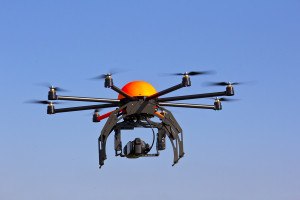Like so many new technologies, drones are both wonderful and terrible. The same gadgets that can monitor oil fields, track criminals and find missing children could also invade privacy, disrupt other aircraft and commit terrorism.
So the Federal Aviation Administration has its work cut out. By the end of the year, the agency is expected to propose rules governing commercial drone flights, which are now prohibited without an exemption. Its top priority is protecting the public. But as it attempts to impose some order on this new and vibrant industry, it should also be careful not to unduly impede innovation.
 Drones, it must be said, are causing a lot of mayhem lately. Alarming near-misses with larger aircraft are increasingly common. Safety incidents have surged to about 40 a month in the U.S. Unmanned aircraft have mysteriously disappeared, wreaked havoc at national parks and sparked a soccer riot. (Granted, that last was in Serbia, but who’s to say the same thing couldn’t happen at a New York Jets game?)
Drones, it must be said, are causing a lot of mayhem lately. Alarming near-misses with larger aircraft are increasingly common. Safety incidents have surged to about 40 a month in the U.S. Unmanned aircraft have mysteriously disappeared, wreaked havoc at national parks and sparked a soccer riot. (Granted, that last was in Serbia, but who’s to say the same thing couldn’t happen at a New York Jets game?)
Domesticating Drones
With such chaos likely to worsen as the technology proliferates, some manner of new regulation is clearly in order. Yet not all drones are alike, and the FAA’s rules should be tailored according to reasonable assessments of risk.
One recent analysis, for instance, found that drones lighter than three pounds, flying lower than 400 feet and staying clear of airports, would pose a negligible risk to U.S. airspace. That suggests a lighter regulatory touch is appropriate, especially since most commercial applications will fall within those parameters.
For one thing, pilots of such drones should have different licensing requirements than those flying larger and more dangerous ones. The FAA is reportedly going to require that all commercial operators be certified much as a normal airplane pilot would. That’s an unreasonable imposition. Better to have a separate, less burdensome certification for small commercial operators, one that ensures they’re qualified to communicate with air-traffic controllers and understand basic aeronautics but that doesn’t mandate hours of training in a traditional cockpit.
That process should also include instruction in best practices for protecting privacy and personal data – clearer guidelines on both counts from the Commerce Department would be welcome – and for minimizing safety risks to the public on the ground. Commercial operators should also have to obtain liability insurance, avoid controlled airspace and keep their planes within their line of sight. Technology for limiting a drone’s altitude and flight path is already available, and Congress should consider mandating it in new models – which would be a good way to ensure that hobbyists are following the rules, too.
Beyond such restrictions, the U.S. legal system should be adequate for handling many of the foreseeable problems drones could cause – accidentally injuring someone, say, or damaging property – and any novel legal questions are better dealt with as they arise, not by trying to anticipate everything that might go wrong.
The history of information-age innovation shows that the best uses of many technologies only become apparent after years of trial and error. Drones will be no different. The FAA’s job is to allow companies to engage in trials – while minimizing the risks that any errors might pose to the public.
Was this article valuable?
Here are more articles you may enjoy.

 Standard Chartered Settles $2 Billion Iranian Sanction Suit in London
Standard Chartered Settles $2 Billion Iranian Sanction Suit in London  Atmospheric River to Flood Pacific Northwest Through Week
Atmospheric River to Flood Pacific Northwest Through Week  Verlan Files Subro Suit Against Georgia Chemical Plant After $20M Payout on Fire
Verlan Files Subro Suit Against Georgia Chemical Plant After $20M Payout on Fire  ‘Super Roofs’ Are Rewarding Insurers, Cat Bond Investors and Homeowners
‘Super Roofs’ Are Rewarding Insurers, Cat Bond Investors and Homeowners 